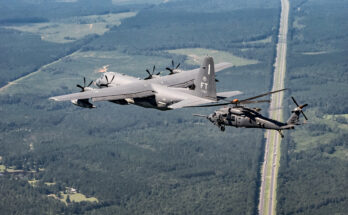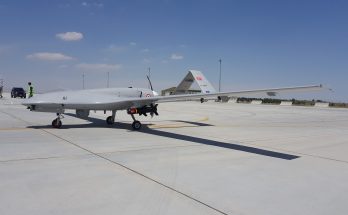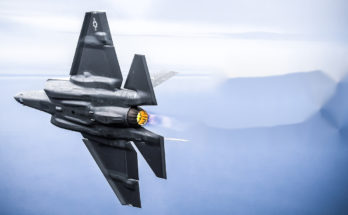
Bell V-280. Image – Bell
The U.S. Army has selected the Bell V-280 tiltrotor aircraft as the service’s new Future Long Range Assault Aircraft (FLRAA). The V-280 had been competing for the FLRAA contract against the Defiant X compound helicopter from Sikorsky and Boeing.
The FLRAA is initially aimed at augmenting and eventually replacing the Army’s UH-60 Black Hawk utility/tactical transport helicopters. The service has approximately 2,000 Black Hawks either in service or planned for delivery over the next few years. The Army has yet to specify a total planned buy for the FLRAA, but the new rotorcraft is unlikely to replace the Black Hawks on a strict one-for-one basis. V-280s and UH-60s can be expected to fly alongside each other in the Army fleet for many years.
Program plans call for the initial delivery of a FLRAA prototype in FY25. First unit equipped is planned for FY30.
The FLRAA development contract awarded to Bell Textron has an initial value of $232 million, and a ceiling of $1.36 billion with the exercise of options. This initial contract covers refinements to the weapon system design as well as activities related to sustainment, digital enterprise, manufacturing, systems integration, flight testing, and airworthiness qualification. The initial phase will also include development of a virtual prototype of the new rotorcraft.
The overall FLRAA program has a potential value of some $70 billion, depending on the size of the Army acquisition and possible Foreign Military Sales. The V-280, with its freshly minted imprimatur from the U.S. Army, will be a strong contender on the global market for future buys of utility and tactical transport rotorcraft.
For the longer term, the Army has been considering development of an attack rotorcraft derived from the FLRAA utility model. An attack version would be used to replace the service’s Apache helicopters. In addition, the V-280 could be used as the basis for replacements for the U.S. Marine Corps’ AH-1Z attack helicopters and UH-1Y transports. The Navy could acquire a maritime strike version to replace its MH-60R/S Seahawk helicopters and Fire Scout unmanned aerial vehicles. A V-280 variant could also become a new combat rescue helicopter for the U.S. Air Force.
Many, if not all, of these acquisitions will likely be open to competition, however. Much of this competition can be expected to come from Sikorsky and Boeing, possibly with rotorcraft designs based on the Defiant X or at least incorporating considerable technology from the Defiant X program or Sikorsky’s X2 technology effort.
A Blow to Sikorsky, Yet Hope Remains
The loss of the FLRAA contract is a blow to Sikorsky. The Black Hawk represents a substantial portion of the company’s production output each year, and not winning the contract for what is in effect the Army’s eventual Black Hawk replacement will result in a shift in focus for the company’s future business and a restructuring of its product line. At this writing, Sikorsky and Boeing had not yet decided whether to formally protest the FLRAA contract award.
The negative effect on Sikorsky of the loss of the FLRAA contract, though, should not be overstated. Sikorsky will be producing Black Hawks for the Army into the late 2020s as the service’s UH-60M program of record is completed, and Black Hawk production for export can be expected to continue well beyond that timeframe. In addition, upgrade, modification, and sustainment work on the large number of existing Black Hawks around the globe will help keep the company busy. In addition, Sikorsky is a finalist for the Army’s Future Attack Reconnaissance Aircraft (FARA) program, which is also the subject of a competition between Sikorsky and Bell.
The FARA is slated to fill the armed scout role for the Army, a role currently undertaken by Apache helicopters and unmanned aerial vehicles. Award of the FARA contract is scheduled for FY25. The competing FARA designs are the Sikorsky Raider X and the Bell 360 Invictus. As with the FLRAA, the first unit equipped date for the FARA is FY30.
The FLRAA and the FARA will be the first rotorcraft to emerge from the Pentagon’s Future Vertical Lift (FVL) program, which involves the procurement of a series of all-new rotorcraft to modernize the fleets of the U.S. services. The goal of the FVL effort is to develop and produce next-generation rotorcraft across the capability spectrum. These rotorcraft are intended to fill various future U.S. military helicopter replacement needs. The FLRAA and the FARA will also be the first all-new rotorcraft to be acquired by the U.S. military since the Bell/Boeing V-22.
Another noteworthy future opportunity is the Next Generation Rotorcraft Capability (NGRC) initiative launched by France, Germany, Greece, Italy, and the U.K. under NATO auspices. This effort is initially aimed at development and production of a new medium-class multirole rotorcraft to replace existing assets in allied fleets starting in the 2035-2040 timeframe. While a European solution (from Airbus Helicopters and/or Leonardo) may be the probable winner here, there could well be potential for some type of teaming arrangement with Sikorsky and Boeing for the use of Defiant X technology in the eventual design.
Forecast International’s Rotorcraft Forecast provides complete coverage of the worldwide rotorcraft market, ranging from two-seat pistons such as the Robinson R22 up to giant turbine helicopters such as the Russian Helicopters Mi-26. Also included is coverage of tiltrotor aircraft such as the Leonardo AW609 and Bell/Boeing V-22 Osprey. Both the military and civil markets are covered. Due to the nature of present-day conflict, rotorcraft acquisition continues to be a priority for the world’s militaries. And the civil market, despite some current difficulties, has considerable long-term potential. An annual subscription includes nearly 60 reports, most with a 10-year unit production forecast. Five Market Segment Analyses explore the trends and dynamics impacting the various segments of the rotorcraft market, and discuss longer-term programs such as the U.S. military’s Future Vertical Lift project. For more details click here.
Raymond Jaworowski currently co-authors three of Forecast International's best-selling products: Civil Aircraft Forecast, Military Aircraft Forecast, and Rotorcraft Forecast. As a contributor to Aviation Week & Space Technology's Aerospace Source Book, he has authored Aircraft Outlooks, and provided input for the publication's Aircraft Specifications tables. Raymond has represented Forecast International at numerous conferences and trade shows, often as a featured speaker. He is a member of the American Helicopter Society. Prior to joining Forecast International, he worked at Industry News Service and, earlier, interned at the U.S. State Department's Bureau of Intelligence and Research.




